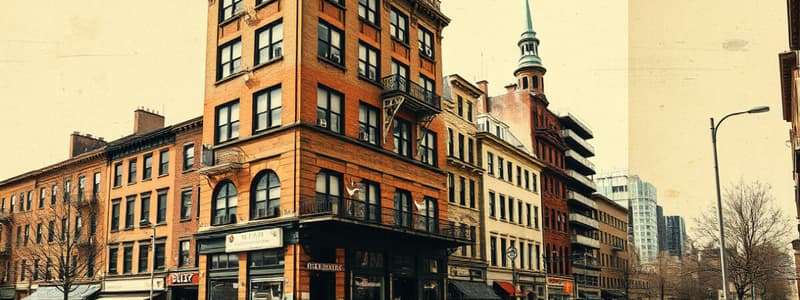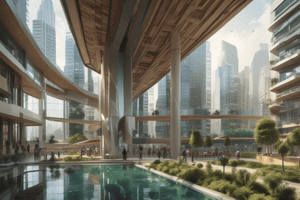Podcast
Questions and Answers
What are the three components an environmental image may be analyzed into?
What are the three components an environmental image may be analyzed into?
identity, structure, and meaning
What does identity refer to in the context of an environmental image?
What does identity refer to in the context of an environmental image?
- The emotional connection to the object
- Equality with something else
- The distinction of an object from other things (correct)
- The spatial relation to the observer
A good image must not be clear or well integrated.
A good image must not be clear or well integrated.
False (B)
What is 'imageability'?
What is 'imageability'?
Which of the following is a criterion for a 'good' image?
Which of the following is a criterion for a 'good' image?
An image useful for making an exit must require recognition of a ______ as a distinct entity.
An image useful for making an exit must require recognition of a ______ as a distinct entity.
What does the concept of imageability not necessarily connote?
What does the concept of imageability not necessarily connote?
The design of our cities does not require consideration of how they are perceived.
The design of our cities does not require consideration of how they are perceived.
What is city design considered to be?
What is city design considered to be?
What is one reason the author gives for the difficulty of experiencing a city?
What is one reason the author gives for the difficulty of experiencing a city?
Legibility is considered unimportant in the design of a city.
Legibility is considered unimportant in the design of a city.
What does the author suggest is rarely controlled in the development of cities?
What does the author suggest is rarely controlled in the development of cities?
The city is a product of many _____ who modify its structure.
The city is a product of many _____ who modify its structure.
What can a vivid physical setting enhance according to the author?
What can a vivid physical setting enhance according to the author?
What term does the author use to describe the clarity of cityscape?
What term does the author use to describe the clarity of cityscape?
What does the author claim aids in navigation within a city?
What does the author claim aids in navigation within a city?
What does the author mean by the term 'environmental image'?
What does the author mean by the term 'environmental image'?
According to the author, everyone can navigate chaotic environments without effort.
According to the author, everyone can navigate chaotic environments without effort.
Flashcards are hidden until you start studying
Study Notes
The Image of the Environment
- Cities offer a unique pleasure, serving as vast constructions perceived over time.
- City design is a temporal art that often lacks the controlled sequences of other arts, like music.
- Perceptions of a city are fragmented and influenced by various factors, including weather and personal memories.
- The relationship of the city’s physical structure to its inhabitants plays a critical role in forming its image.
- Citizens experience urban environments holistically, integrating sensory cues with memories of past engagements.
- The clarity or "legibility" of a cityscape is crucial for effective navigation and emotional connection with the environment.
- Urban environments are dynamic, influenced by builders who continually modify their structures.
- Beauty in city environments is scarce, with few American cities exhibiting consistently fine quality.
- Many Americans recognize the ugliness of their surroundings but are less aware of the potential delights of harmonious environments.
- Humans often navigate cities using cues from visual sensations and other sensory inputs, showcasing a vital ability for orientation.
Legibility and Way-Finding
- Legibility pertains to the distinctiveness and clarity of environmental features that support efficient way-finding.
- Losing one's way in a city can cause significant anxiety; familiarity with distinctive features enhances the sense of security.
- A distinctive environment not only aids survival but also enriches the depth of human experiences.
- Individuals develop a generalized mental image of their surroundings, synthesized from immediate sensations and memories.
- Clear environments serve as frameworks for organizing activities and beliefs, facilitating personal growth.
- Vivid settings can enhance group communication, becoming sources for collective memories and social myths.
The Role of the Observer
- Environmental images result from a two-way interactive process between observers and their surroundings.
- Observers play an active role, selecting and organizing elements they perceive based on personal purposes.
- The coherence of an image can arise from long familiarity with disorder or from predefined stereotypes.
- Cultural and physiological factors shape the differing systems of orientation between observers.
- Examples of orientation systems include fixed directional systems and those linked to personal experiences.
Structure and Identity
- The city image can be divided into formal elements: path, landmark, edge, node, and district.
- These elements provide a framework through which individuals can derive meaning and identify with their urban environment.
- The meanings attached to urban forms can be distinct from their physical attributes, allowing deeper analysis of a city's identity.### Components of Environmental Image
- Identity: Recognizing objects distinctly from others, denoting individuality.
- Structure: Relates to the spatial arrangement of objects and their relations to observers and each other.
- Meaning: Represents the practical or emotional significance an object holds for the observer.
Qualities of a Useful Image
- Must be sufficient: Enables navigation and comprehension of the environment to aid functionality.
- Needs to be clear: Readability is essential for reducing cognitive load.
- Should ensure safety: Multiple cues are necessary to avoid failure in emergencies.
- Must allow for flexibility: Open-endedness is important for ongoing exploration and adaptation.
City Imageability
- Defined as the probability of a physical object evoking a strong mental image for diverse observers.
- Imageability encompasses qualities like clarity, distinctiveness, and visibility.
- Strongly imageable environments facilitate the formation of vivid mental images that enhance orientation and interaction.
Historical Context
- Stern's concept of apparency highlights the importance of clarity and harmony in images for meaningful interpretation.
- Urban environments should balance physical clarity with the organic development of meaning over time.
Learning and Perception
- Imageability is often a two-way process influenced by both observers and the environment.
- Techniques such as symbolic aids and directional devices can enhance environmental understanding and orientation.
- Personal experiences can lead to the formation of strong mental images through repetition and familiarity.
The Role of Design in Urban Environments
- Cities must be designed to promote a high degree of imageability, aiding identification and cognitive structuring.
- Historical limitations in modifying large environments hindered the ability to enhance imageability at scale.
- Modern techniques, such as urban planning, enable the creation of cohesive environments capable of fostering clear, distinguishable images.
Examples of Highly Imageable Urban Environments
- Venice: Known for its distinctive layout and navigable structure.
- In the U.S.: Parts of cities like Manhattan and San Francisco are often cited for their visual clarity and imageability.
Overcoming Perceptual Challenges
- The inherent complexity of urban environments requires improved methods for perceiving and understanding spatial relationships.
- The challenge lies in connecting components of the environment, analogous to musical coordination across different sources.
Future Directions
- Emphasizing the development of urban landscapes that promote perceptual clarity and spatial organization is crucial for improving imageability and enhancing human experience.
Studying That Suits You
Use AI to generate personalized quizzes and flashcards to suit your learning preferences.






